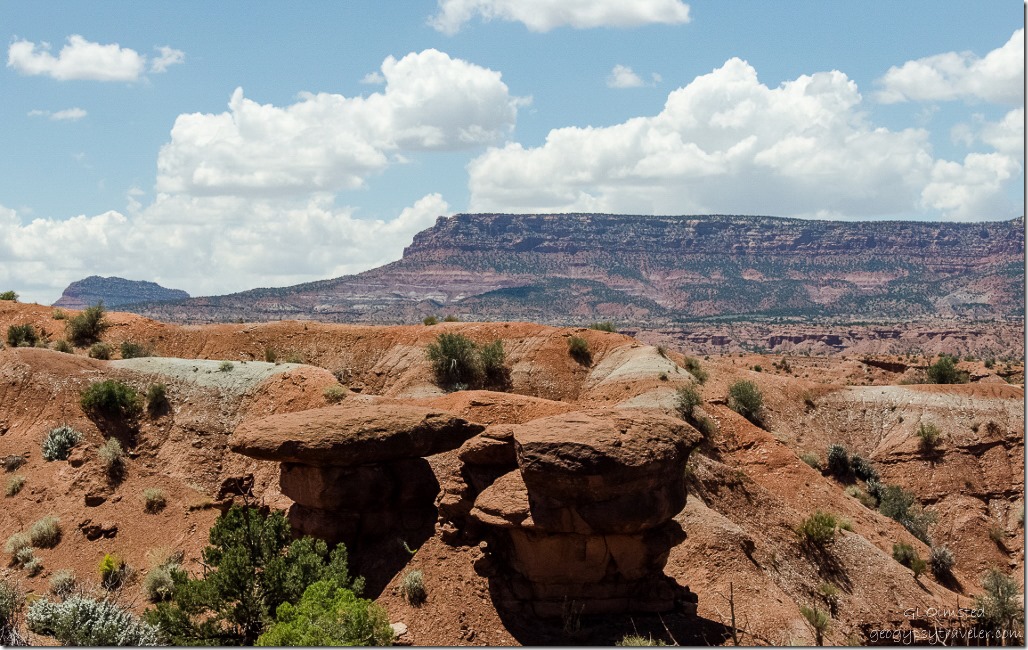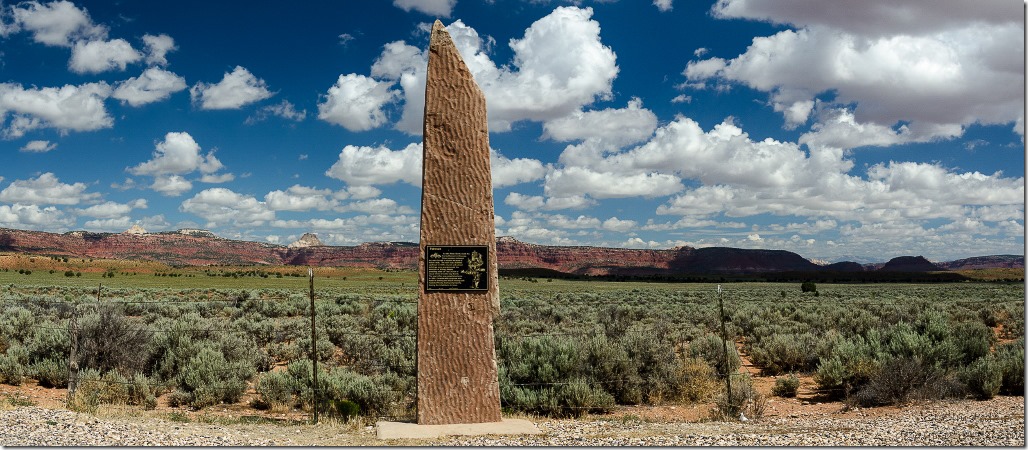 Bill talks about the Paria River all the time and wanted to show me the remains of the old, and not so old, Paria townsite where movies were made. So we took a drive and someone was actually filming in the area. In fact when we pulled off State Route 89 onto the Paria River Road there was a bright yellow sign that read “Monolith”. Not the sign or monolith in the photo above.
Bill talks about the Paria River all the time and wanted to show me the remains of the old, and not so old, Paria townsite where movies were made. So we took a drive and someone was actually filming in the area. In fact when we pulled off State Route 89 onto the Paria River Road there was a bright yellow sign that read “Monolith”. Not the sign or monolith in the photo above.
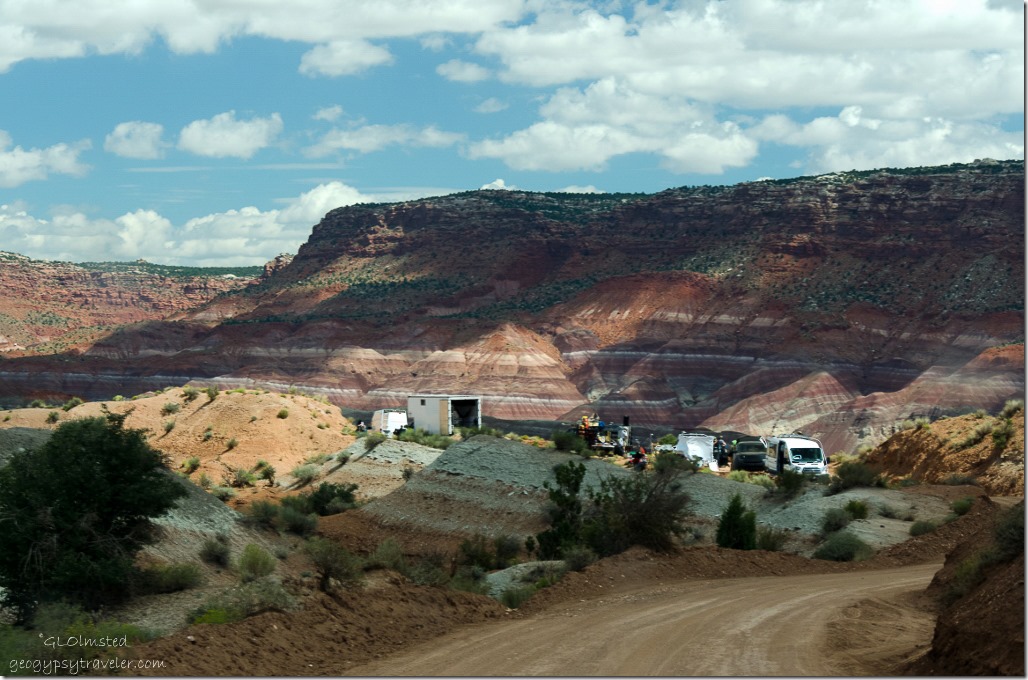 We stopped when we saw a couple guys standing along this rather deserted looking road and I asked what they were filming. “A movie” was the reply along with “bet you don’t know what it’s called.” No duh. I’ll bet it’s called Monolith. I don’t watch movies so can only guess about this movie even after doing some Googling.
We stopped when we saw a couple guys standing along this rather deserted looking road and I asked what they were filming. “A movie” was the reply along with “bet you don’t know what it’s called.” No duh. I’ll bet it’s called Monolith. I don’t watch movies so can only guess about this movie even after doing some Googling.
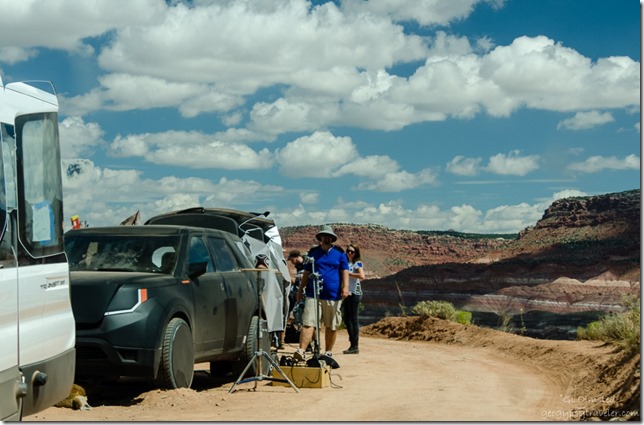 We didn’t see any actual filming but the crew had the road half blocked for at least 100 yards including one person with their ass sticking out who seemed hesitant to move. Of course this requires paid permits and we saw two BLM government rigs in the foray, they are suppose to be watching for compliance on this fragile landscape. Wonder if they got to be in the movie?
We didn’t see any actual filming but the crew had the road half blocked for at least 100 yards including one person with their ass sticking out who seemed hesitant to move. Of course this requires paid permits and we saw two BLM government rigs in the foray, they are suppose to be watching for compliance on this fragile landscape. Wonder if they got to be in the movie?
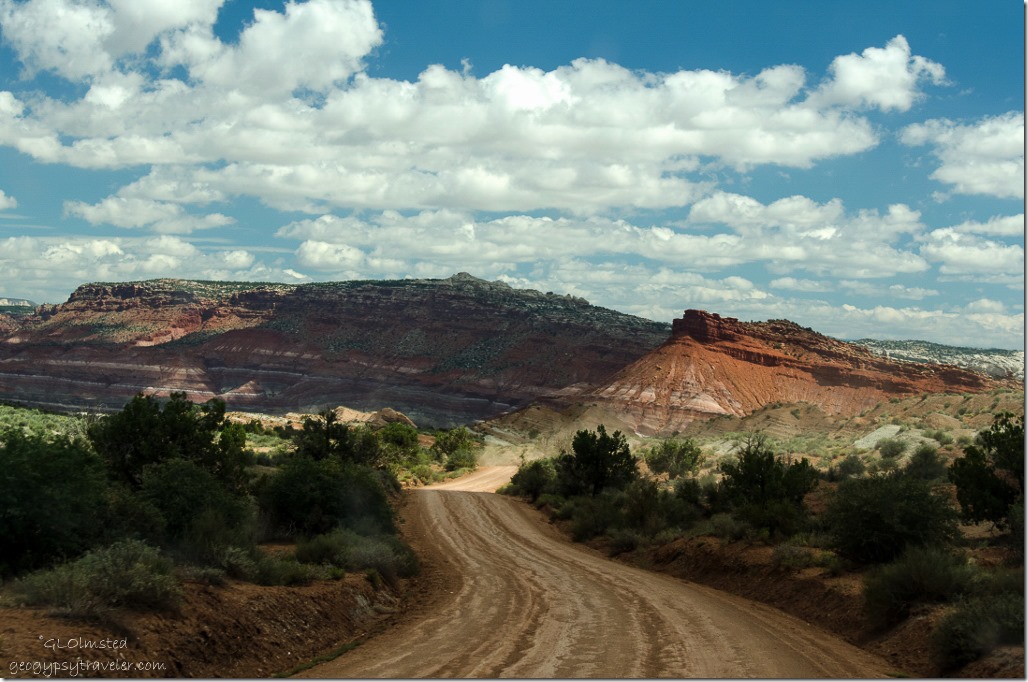 The Paria River Road is 6 miles (9.6 kms) long, and becomes rather steep and twisting near the end, as it crosses the undulating banded hills that cover this area. The surrounding landscape of carved stone in southern Utah’s Grand Staircase-Escalante National Monument continues to absorb me with its various colors, shapes, lines and layers.
The Paria River Road is 6 miles (9.6 kms) long, and becomes rather steep and twisting near the end, as it crosses the undulating banded hills that cover this area. The surrounding landscape of carved stone in southern Utah’s Grand Staircase-Escalante National Monument continues to absorb me with its various colors, shapes, lines and layers.
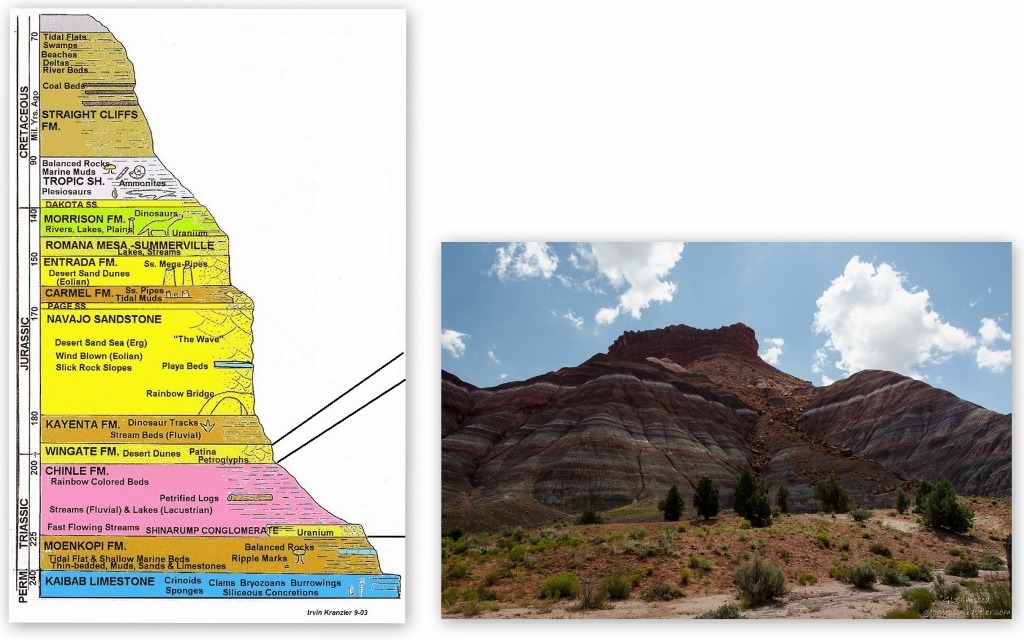 The cliffs on either side of the river valley are equally layered and multi-colored, with alternating red, white, purple and grayish-blue strata, part of the Petrified Forest Member of the Chinle Formation topped by Wingate Sandstone. The Chinle Formation was deposited during the Triassic Period between 225 and 200 million years ago under different climatic conditions dominated by wet environments such as streams, lakes and wetlands with distributary channels. Eventually the climate shifted and dryer environments prevailed such as seasonal stream systems and floodplains followed by dunes.
The cliffs on either side of the river valley are equally layered and multi-colored, with alternating red, white, purple and grayish-blue strata, part of the Petrified Forest Member of the Chinle Formation topped by Wingate Sandstone. The Chinle Formation was deposited during the Triassic Period between 225 and 200 million years ago under different climatic conditions dominated by wet environments such as streams, lakes and wetlands with distributary channels. Eventually the climate shifted and dryer environments prevailed such as seasonal stream systems and floodplains followed by dunes.
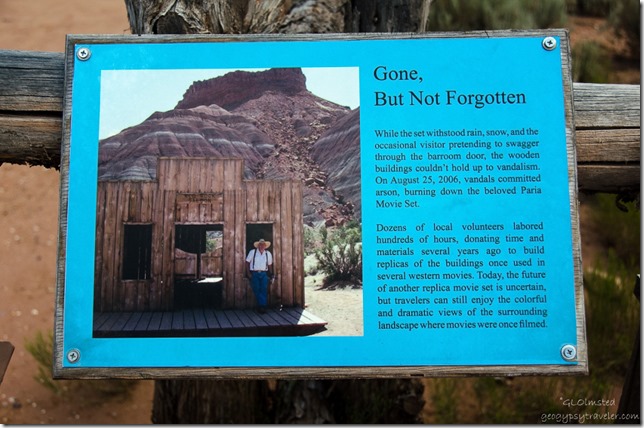 First stop at a parking lot where the Paria movie set once stood. Not to be confused with the original townsite of Paria, or Pahreah, the movie set was constructed in 1962 about a mile west to avoid flooding by the Paria River for the filming of the Rat Pack’s Seargent 3. Then after the filming of The Outlaw Josey Whales in 1976 the site was abandoned and fell apart. Local volunteers have rebuilt the fake town, I believe twice, and vandals burned it down so now there’s nothing but interpretive signs at a parking lot with a toilet.
First stop at a parking lot where the Paria movie set once stood. Not to be confused with the original townsite of Paria, or Pahreah, the movie set was constructed in 1962 about a mile west to avoid flooding by the Paria River for the filming of the Rat Pack’s Seargent 3. Then after the filming of The Outlaw Josey Whales in 1976 the site was abandoned and fell apart. Local volunteers have rebuilt the fake town, I believe twice, and vandals burned it down so now there’s nothing but interpretive signs at a parking lot with a toilet.
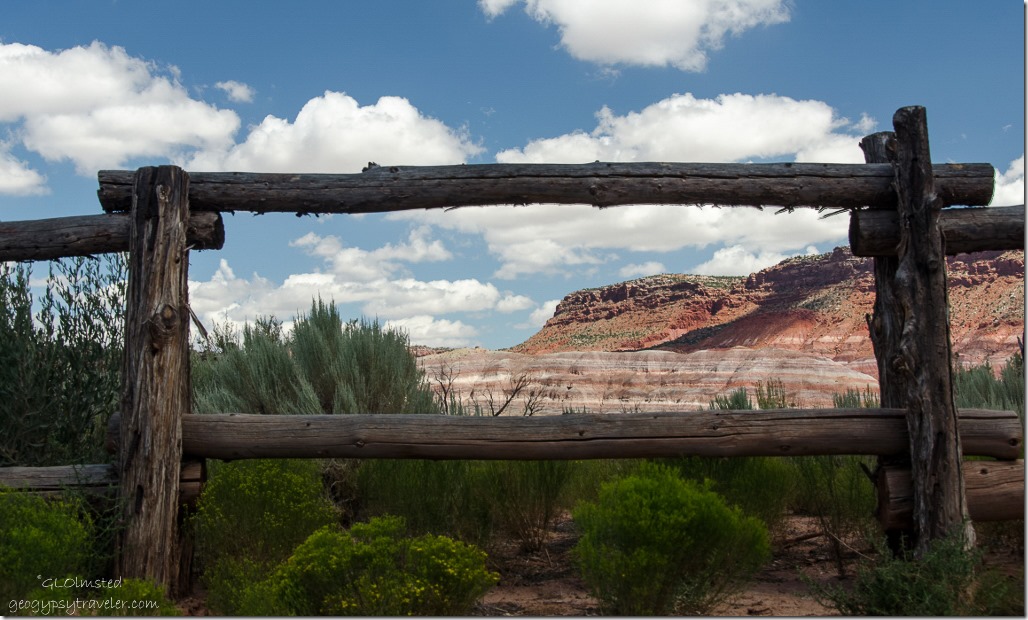 The rugged surroundings easily bring back memories of Clint Eastwood riding across a dry land in search of water.
The rugged surroundings easily bring back memories of Clint Eastwood riding across a dry land in search of water.
 A little further down the road is a pioneer cemetery renovated in 2001 by descendants of the Smiths and Smithsons with a memorial stone listing the known buried.
A little further down the road is a pioneer cemetery renovated in 2001 by descendants of the Smiths and Smithsons with a memorial stone listing the known buried.
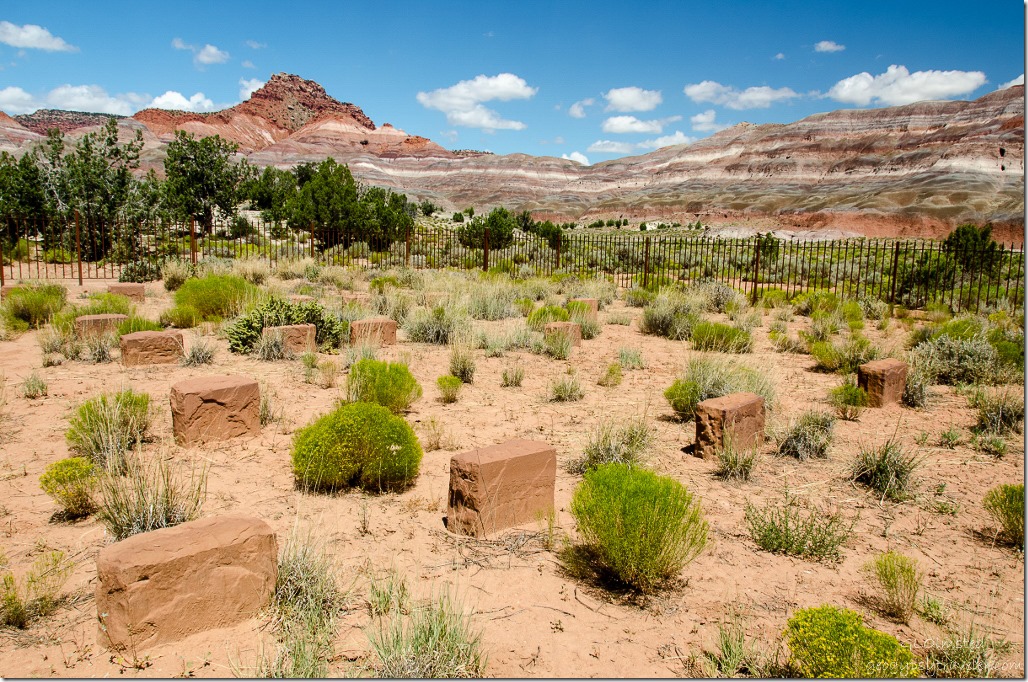 Yet the unmarked headstones number more than the known, amongst them some Paiute people, almost blending in with the harsh land where people have lived over 1000 years.
Yet the unmarked headstones number more than the known, amongst them some Paiute people, almost blending in with the harsh land where people have lived over 1000 years.
 Ancient rock art, which I did not see, from 4000 BC suggests use of the canyon as a travel corridor. Yet settlement didn’t occur until 1865 by a Mormon group led by Peter Shirts who tried to farm on the too dry desert soil. In 1871 John D. Lee constructed a dam and irrigation ditches which helped the town grow and included a general store, church and a number of houses. The town of 47 families hit hard times when the Paria River flooded every year from 1883-88, washing away fields and even some buildings. People started to move away and by 1892 there were only eight families left.
Ancient rock art, which I did not see, from 4000 BC suggests use of the canyon as a travel corridor. Yet settlement didn’t occur until 1865 by a Mormon group led by Peter Shirts who tried to farm on the too dry desert soil. In 1871 John D. Lee constructed a dam and irrigation ditches which helped the town grow and included a general store, church and a number of houses. The town of 47 families hit hard times when the Paria River flooded every year from 1883-88, washing away fields and even some buildings. People started to move away and by 1892 there were only eight families left.
“There is some tolerably good land here, but very little of it is safe from washing away.” –Edwin B. Woolley, Jr., 1869
In later years the film industry became interested in using the picturesque ghost town with its canyon vista background as a location for making westerns like Buffalo Bill in 1943. Yet the constant struggle against the flooding Paria River eventually led to the move mentioned above.
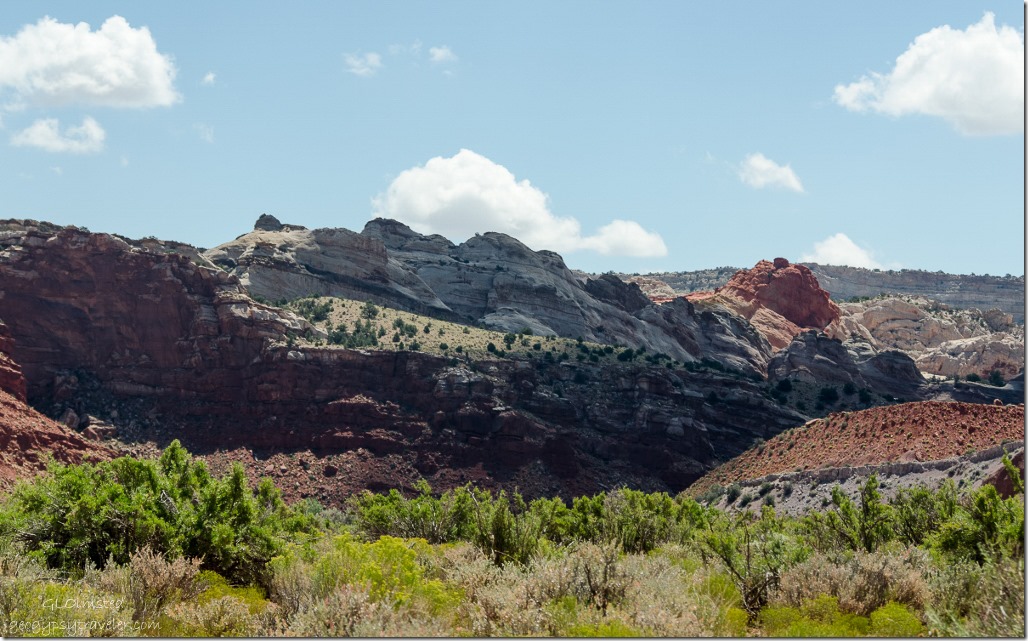 We continued down the road seeing breathtaking beauty around every curve.
We continued down the road seeing breathtaking beauty around every curve.
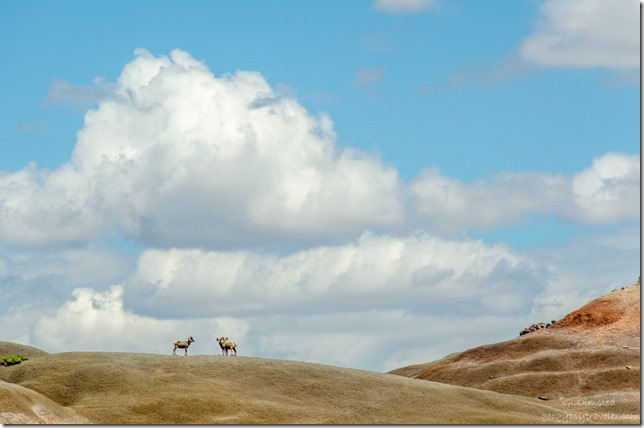 And then the excitement of seeing three big-horn sheep standing on the horizon.
And then the excitement of seeing three big-horn sheep standing on the horizon.
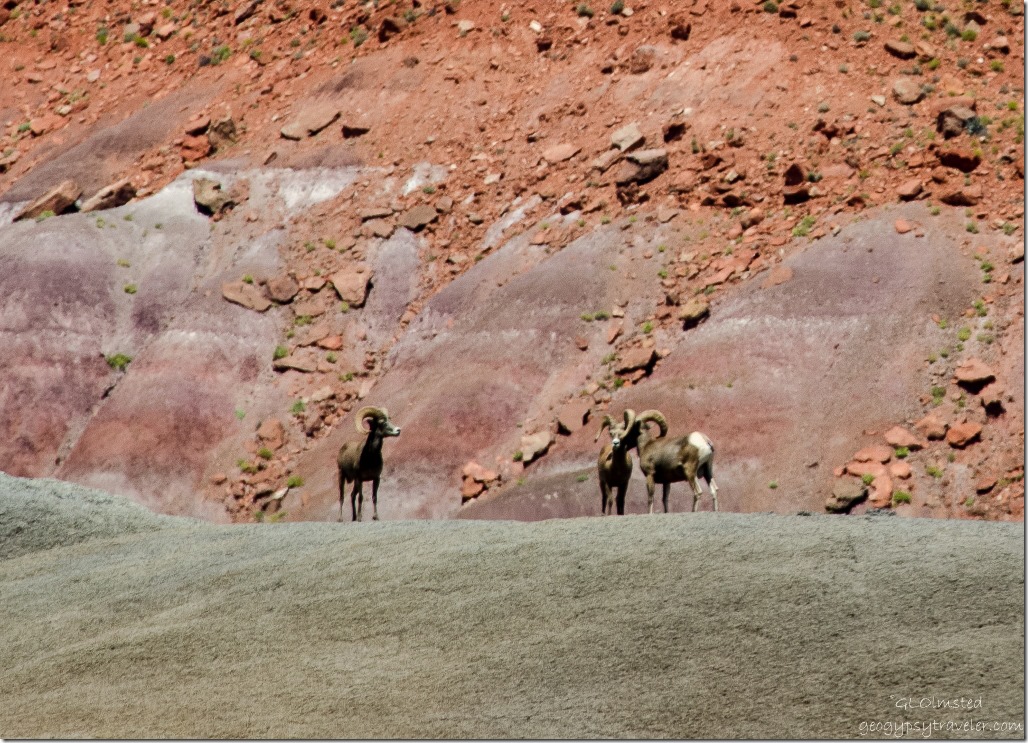 Once parked at the end of the road we watched the sheep for at least 20 minutes from our picnic place along a dry but muddy branch of the Paria. We heard them clack horns and would guess these three males were playing around.
Once parked at the end of the road we watched the sheep for at least 20 minutes from our picnic place along a dry but muddy branch of the Paria. We heard them clack horns and would guess these three males were playing around.
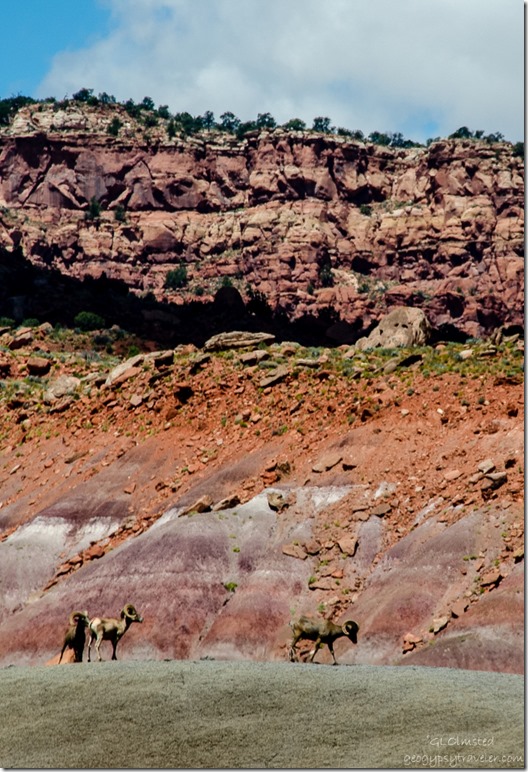 I took so many photos of them but without a bigger lens they mostly look like brown blobs. Can you see them way up there with that drop dead gorgeous backdrop?
I took so many photos of them but without a bigger lens they mostly look like brown blobs. Can you see them way up there with that drop dead gorgeous backdrop?
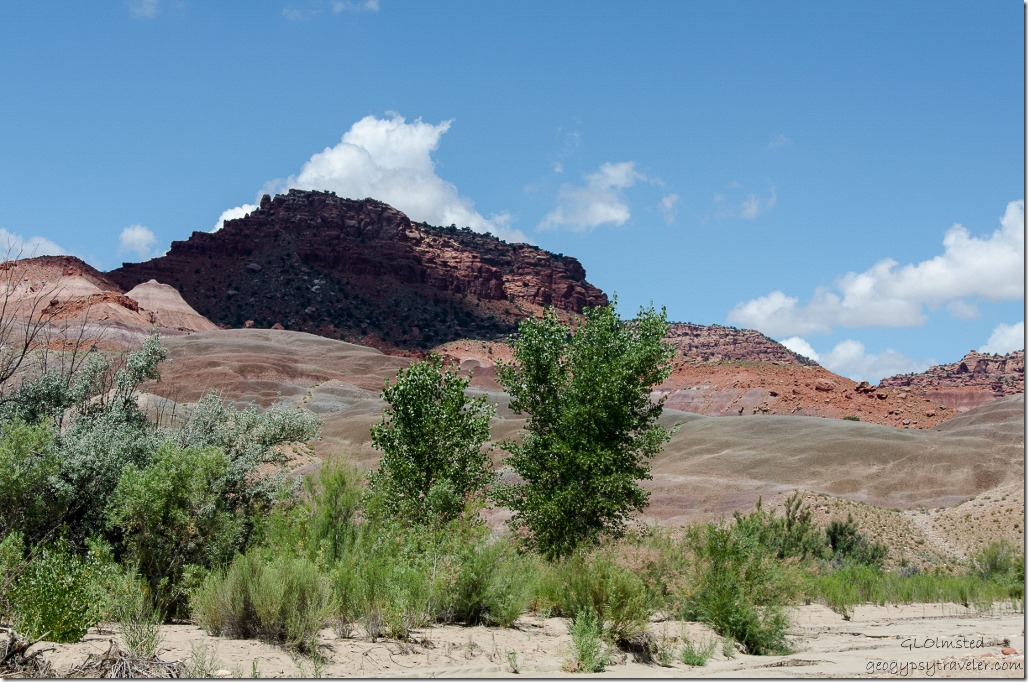 Then a man named Ed showed up with two D800 Nikons and a lens as long as my arm. Did I drool in envy? Oh yes, but then he handed it to me and the set up weighs too much for me to hand hold, even with the ISO up to 6400 where he sets it. He even offered to let me load it on my camera but I passed knowing the cost of replacement.
Then a man named Ed showed up with two D800 Nikons and a lens as long as my arm. Did I drool in envy? Oh yes, but then he handed it to me and the set up weighs too much for me to hand hold, even with the ISO up to 6400 where he sets it. He even offered to let me load it on my camera but I passed knowing the cost of replacement.
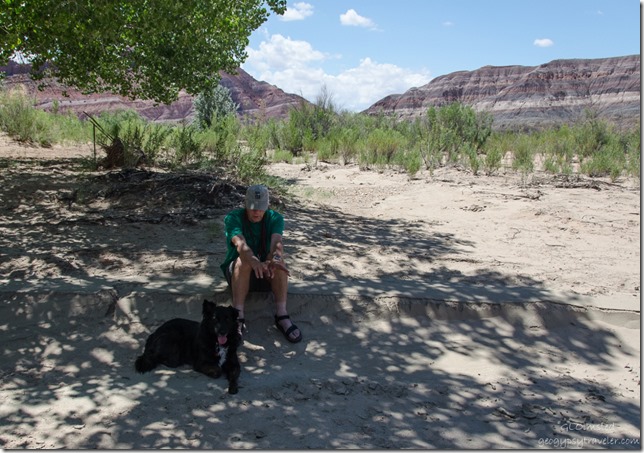 We sat and ate lunch with the 87-year old Ed from Sun City near Phoenix. He asked about road conditions to places like White Pocket and admitted that even with his 4×4 he hesitated to go to these difficult places alone. Bill offered to take him and we gave him our contact information. He left a Bill a message days later and mentioned going in September so I look forward to returning also.
We sat and ate lunch with the 87-year old Ed from Sun City near Phoenix. He asked about road conditions to places like White Pocket and admitted that even with his 4×4 he hesitated to go to these difficult places alone. Bill offered to take him and we gave him our contact information. He left a Bill a message days later and mentioned going in September so I look forward to returning also.
 We passed on actually crossing the Paria River to see the few remains of the original town site because the mud that wasn’t dry quickly clung to shoes making them three times larger with each sucking sound of possible shoe loss. Equally bad for dogs. Good excuse to return another time.
We passed on actually crossing the Paria River to see the few remains of the original town site because the mud that wasn’t dry quickly clung to shoes making them three times larger with each sucking sound of possible shoe loss. Equally bad for dogs. Good excuse to return another time.
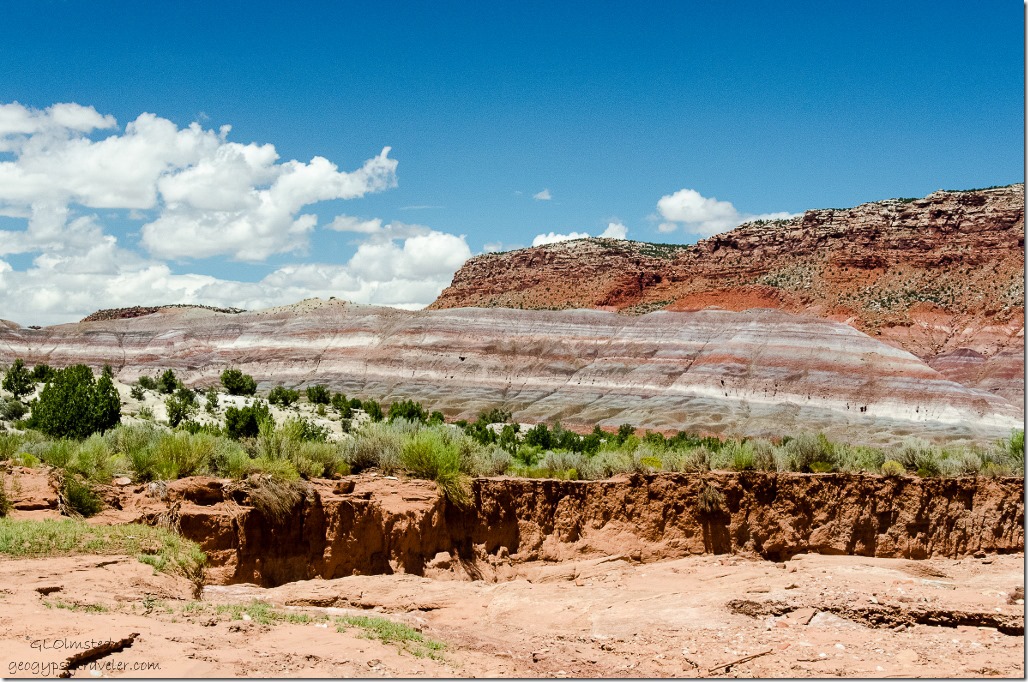 So we turned around to see these luscious colored hills from a new direction then continued our journey to Catstair Canyon for some possible petroglyphs.
So we turned around to see these luscious colored hills from a new direction then continued our journey to Catstair Canyon for some possible petroglyphs.

